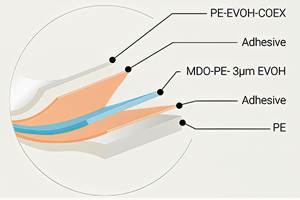Packaging Demand Has Probably Peaked
Consumers are spending less on food and beverage consumption.
The use of plastics packaging is closely tied to production of consumer goods and the food and beverage processing industry. Trends in the economic data that are leading indicators for production in these two industries provide clues as to what will happen to demand for plastics packaging.
Real disposable income is the earliest leading indicator we track for both industries. Disposable income hit all-time highs in recent months. Recently released data even revised upward the level of disposable income reported for the first quarter of 2015. Over the last five months, the one-month rate of change in disposable income has grown faster than the historical average. The annual rate of change shows that disposable income has grown at a rapidly accelerating rate since January 2014.
Yet the accelerating growth in consumer income has not resulted in increased spending. Consumer-goods spending dipped below its average one-month rate of growth in April. And while the annual rate of growth has accelerated, it has not increased as much as expected. This is likely because spending remained robust in 2013 and 2014, even as disposable income saw significantly slower growth. Because consumer-goods spending stayed high with such slow growth in incomes, don’t expect to see accelerating growth in consumer-goods spending, even if disposable income continues to grow faster.
Since 2014, food and beverage consumer spending has moved in the opposite direction of incomes. In fact, food and beverage spending has contracted at an accelerating rate throughout 2015. It’s quite a rare occurrence for food and beverage spending to contract. But historical data shows that disposable income leads food and beverage spending by six to 12 months. So we should see food and beverage spending contract at a slower rate very soon and then perhaps move into accelerating growth in the second half of 2015.
So, the future trend in food and beverage spending seems to be more positive than in consumer-goods spending. Spending tends to lead production by up to six months. Consumer-goods production has seen decelerating growth over the last six months. This is surprising, given the trend in consumer-goods spending. It’s possible that we could see some growth in production of consumer goods. The more likely scenario is that the rate of growth in production will remain relatively unchanged. So packaging demand will probably remain relatively stable in future months.
Despite the contraction in food and beverage spending, production has seen rapidly accelerating growth. Still, I don’t think we will see corresponding growth in production, at least until spending and production come into a better balance. This means we could be entering a period of relatively weaker demand for packaging in the food and beverage industry.
Consumers are getting fatigued despite the increase in their incomes. So look for consumer spending to be relatively soft. This means that demand for packaging likely peaked at the end of the first quarter of 2015.
Related Content
Recycling Terminology Can Be a Minefield, So We Should Tread Lightly
Loose propagation of terms like “recyclable” and “compostable” has already brought down government regulations on labeling. The plastics and packaging industries should take that to heart with other recycle-related language. Like “monomaterial” for example.
Read MoreThin, High-Performance Nylon/PE Barrier Film for Thermoformed Packaging
Südpack’s Multifol Extreme film is well suited for greasy, protein-rich and frozen foods
Read MoreMeasuring Multilayer Plastic Containers Made Easier With Today's Ultrasonic Gauges
Ultrasonic gauge technology has evolved to simplify measurement of very thin layers in plastic containers. Today’s gauges with high-frequency capabilities and specialized software can make multilayer container measurement quick and easy for ordinary users.
Read MoreMultilayer Solutions to Challenges in Blow Molding with PCR
For extrusion blow molders, challenges of price and availability of postconsumer recycled resins can be addressed with a variety of multilayer technologies, which also offer solutions to issues with color, processability, mechanical properties and chemical migration in PCR materials.
Read MoreRead Next
Beyond Prototypes: 8 Ways the Plastics Industry Is Using 3D Printing
Plastics processors are finding applications for 3D printing around the plant and across the supply chain. Here are 8 examples to look for at NPE2024.
Read MoreFor PLASTICS' CEO Seaholm, NPE to Shine Light on Sustainability Successes
With advocacy, communication and sustainability as three main pillars, Seaholm leads a trade association to NPE that ‘is more active today than we have ever been.’
Read MoreSee Recyclers Close the Loop on Trade Show Production Scrap at NPE2024
A collaboration between show organizer PLASTICS, recycler CPR and size reduction experts WEIMA and Conair recovered and recycled all production scrap at NPE2024.
Read More.JPG;width=70;height=70;mode=crop)










